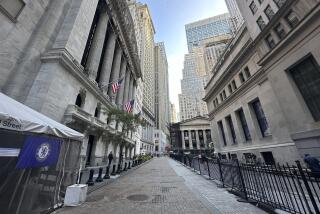Big Banks Boost Prime Rate to 9% : Response to Tighter Fed Inflation Policy Sends Dow Down 37 Points
- Share via
WASHINGTON — Big banks across the country boosted their prime lending rates from 8.5% to 9% on Wednesday in response to higher money-market interest rates and a tighter anti-inflationary stance by the Federal Reserve.
The rise in interest rates knocked Wall Street for a loop, sending the Dow Jones industrial average down 37.80 points to close at its lowest level in three months. Higher interest rates undermine the stock market by luring investors away from stocks into interest-paying securities.
The nationwide increase in the prime rate, which is used as a benchmark for a variety of business and consumer loans, marks the first time major banks have raised borrowing costs since last October’s stock market crash.
The prime rate increase will boost interest rates on most home equity loans, which have become an increasingly popular way of borrowing in the last year because they are one of the few remaining ways available for individuals to continue claiming a full tax deduction for their interest costs.
Little Risk of Recession
Analysts said they expect interest rates to continue to creep upward this year, but they contended that such increases pose little risk of toppling the economy into a recession in 1988.
“We’re in the middle of an upward cycle in interest rates,” said John O. Wilson, chief economist at Bank of America in San Francisco. “But for us to go into recession, it would require short-term interest rates’ moving well into double digits.”
Over the last six weeks, the nation’s central bank has twice engineered modest increases in short-term interest rates, reversing the easier monetary policy that was put in place the day after Wall Street’s 500-point collapse last Oct. 19.
At the beginning of the week, the Fed took steps to boost the federal funds rate--the interest rates on overnight loans between banks--from the roughly 6.8% it averaged last week to a level of 7.125% on Wednesday.
The tightening came after the government disclosed a drop last Friday in the jobless rate to its lowest level in 14 years. Although there was a relatively modest rise in the number of payroll jobs, the dip in April’s overall unemployment rate to 5.4% added to fears among investors that stronger economic growth would begin to push up wages and encourage higher inflation.
‘Clear and Present Danger’
“The Fed has been signaling that it is not going to let any inflationary momentum develop,” said Stephen Axilrod, vice chairman at Nikko Securities in New York and a former chief of the monetary policy staff at the Fed. “The clear and present danger now is that domestic spending will be too strong, not that the economy will be too weak.”
Axilrod said he expects Fed officials to nudge up the federal funds rate to about 7.25% in the weeks ahead by quietly buying and selling U.S. securities in the open market. But he said they might hold back from raising the Fed’s discount rate--the interest rate it charges banks--above its current 6% until there is further evidence that consumer spending is on the rise.
By making short-term borrowing more expensive, the Fed hopes to prevent a surge in domestic spending and to help quell expectations of higher inflation, which have pushed up interest rates in the long-term market for government bonds and home mortgages. Although the Fed’s goal is to keep long-term rates from soaring by showing its determination to keep inflation under control, the immediate effect of its actions is to push up rates across the board.
The move to a higher bank prime rate was led by New York’s Chase Manhattan Bank, which was quickly followed by Citibank, Chemical Bank, Continental Illinois in Chicago, Mellon Bank in Pittsburgh and dozens of other banks around the country. In California, Bank of America, Wells Fargo, Security Pacific, First Interstate and Union Bank, among others, joined the move to a 9% prime.
Boost Widely Predicted
The prime rate boost was widely predicted, because the prime tends to lag behind changes in other interest rates. But many analysts had expected a rise only to the 8.75% rate that a single Washington bank had adopted last week.
On currency markets, the U.S. dollar, which had fallen in earlier overseas trading, moved up after banks began announcing their prime rate increases. The greenback tends to strengthen when the rate on U.S. securities rises in comparison with rates in other countries.
Investors also pulled out of stock markets in Europe, spooked by a report Wednesday in European editions of the Wall Street Journal which suggested that America’s major trading partners were on the verge of pushing their own interest rates up as well in a bid to keep the dollar stable against other currencies.
Interview Clarified
But the newspaper issued a clarification Wednesday of its interview with British Chancellor of the Exchequer Nigel Lawson. It added that it had not included in its report a comment from Lawson cautioning against speculation that foreign central bankers were close to a decision to push interest rates higher. Lawson’s office also issued a statement saying that he had been “misinterpreted.”
But many analysts still expect Japan and West Germany to increase interest rates for domestic reasons in the near future.
More to Read
Inside the business of entertainment
The Wide Shot brings you news, analysis and insights on everything from streaming wars to production — and what it all means for the future.
You may occasionally receive promotional content from the Los Angeles Times.










